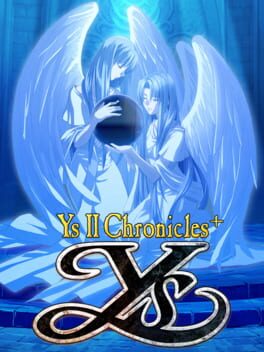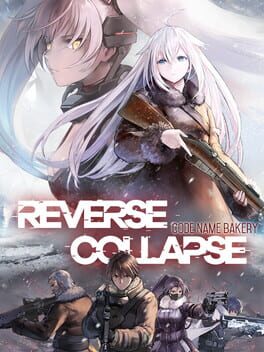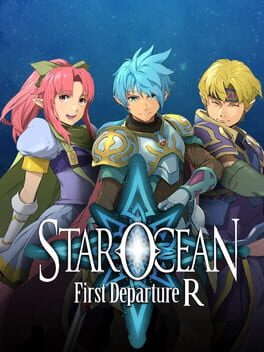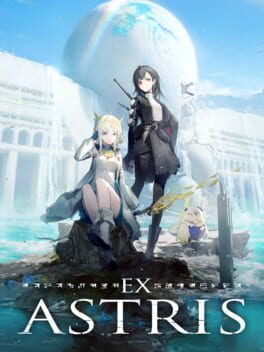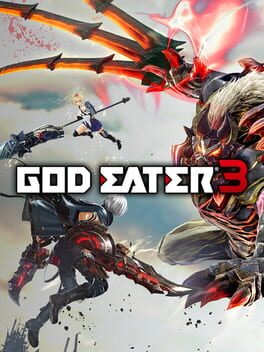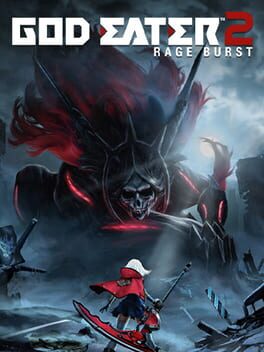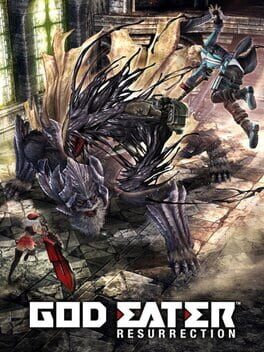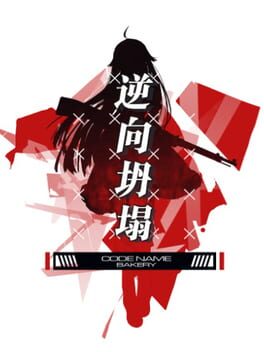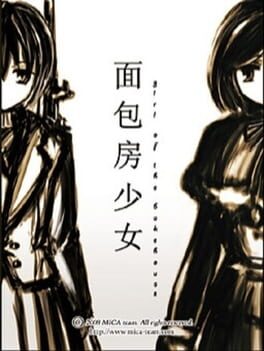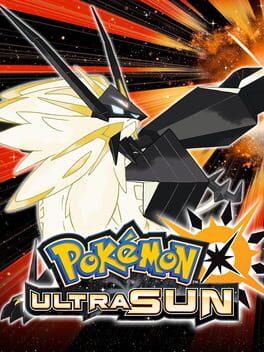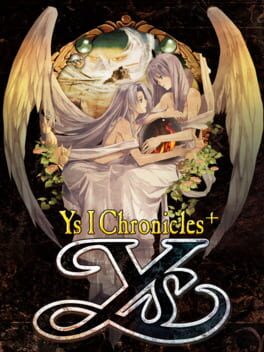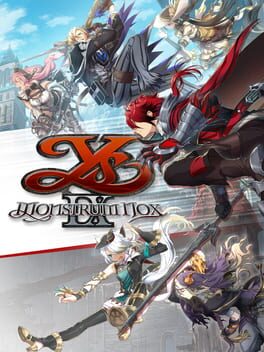ninedrive
2013
Ys II takes everything about Ys I that worked and dials it up by 100. It's a phenomenal sequel with a grandiose scale that keeps you begging for more. As the starting point of Adol's adventure, it embodies Ys at its core and gives insight into the fundamental aspects of this franchise that continue to persist to this day. It's an excellent game and nothing short of it. I mean.. it's Ys, it's going to be a 5/5.
Girls Frontline is a franchise that has meant a lot to me over the last ~7 years. I distinctly remember the announcement of Codename: Bakery Girl remake in January 2018 and being filled with indescribable excitement at the idea of that game being fully realized. It has been almost 6 years since and I can say with no uncertainty that this game surpassed my expectations and is one of the best games I have ever played.
Reverse Collapse takes the original Codename: Bakery Girl and elevates it to an entirely new level. It is a phenomenal remake that surpasses the original in every regard. Every character, story beat, dialogue, interaction, character sprite, artwork, CG, soundtrack, and map/level design is filled with love and attention. You can feel the passion and love for this franchise oozing through every second of this adventure. It is filled with authentic zeal to tell its story reminiscent of Bakehouse and ambition to deliver an engaging experience reminiscent of Codename: Bakery Girl. It is the best parts of Girls Frontline, Girls Frontline: Neural Cloud, Girls Frontline 2, the original Bakehouse, and Codename: Bakery Girl. It is a love letter not only to this franchise and its original vision but also to the fans who have and continue to dedicate themselves to one of the most ambitious stories told.
It's amazing just how deeply I fell in love with the cast: Mendo, Jefuty, Atena, Jevon, and Carl are all such charismatic characters. I can genuinely say I love them all. Jefuty and Mendo in particular are so phenomenal, presenting such engaging chemistry that you can't help but root for them through each story beat. I thoroughly enjoyed the villains and each twist and turn through the Caucasus Mountain region. I loved all the collectibles referencing older characters or events. I loved all the confidential files that took advantage of Girls Frontline's amazing and intricate world. I cannot stress enough how excited I was seeing certain entries. I loved seeing the culmination of this journey and wish so desperately I could experience it for the first time again.
I could go on and on and on and on about Reverse Collapse but ultimately, Reverse Collapse is a game about love, sacrifice, hope, despair, and unyielding determination. It is about doing right by those you love and choosing the impossible, enduring unending tragedy so those you love can live happily and freely. It is a beautiful story about choice and the consequences of it.
To Yuzhong, to Shaonian, to MICA and its talented devs, to XD and everyone involved in this project thank you for delivering an experience so beautiful it will remain with me for years.
And once more to Yuzhong, and MICA, thank you so much for continually writing stories that resonate with so many people. Thank you for Girls Frontline, Neural Cloud, Reverse Collapse and all the stories you've shared in this beautiful world you've crafted.
Reverse Collapse takes the original Codename: Bakery Girl and elevates it to an entirely new level. It is a phenomenal remake that surpasses the original in every regard. Every character, story beat, dialogue, interaction, character sprite, artwork, CG, soundtrack, and map/level design is filled with love and attention. You can feel the passion and love for this franchise oozing through every second of this adventure. It is filled with authentic zeal to tell its story reminiscent of Bakehouse and ambition to deliver an engaging experience reminiscent of Codename: Bakery Girl. It is the best parts of Girls Frontline, Girls Frontline: Neural Cloud, Girls Frontline 2, the original Bakehouse, and Codename: Bakery Girl. It is a love letter not only to this franchise and its original vision but also to the fans who have and continue to dedicate themselves to one of the most ambitious stories told.
It's amazing just how deeply I fell in love with the cast: Mendo, Jefuty, Atena, Jevon, and Carl are all such charismatic characters. I can genuinely say I love them all. Jefuty and Mendo in particular are so phenomenal, presenting such engaging chemistry that you can't help but root for them through each story beat. I thoroughly enjoyed the villains and each twist and turn through the Caucasus Mountain region. I loved all the collectibles referencing older characters or events. I loved all the confidential files that took advantage of Girls Frontline's amazing and intricate world. I cannot stress enough how excited I was seeing certain entries. I loved seeing the culmination of this journey and wish so desperately I could experience it for the first time again.
I could go on and on and on and on about Reverse Collapse but ultimately, Reverse Collapse is a game about love, sacrifice, hope, despair, and unyielding determination. It is about doing right by those you love and choosing the impossible, enduring unending tragedy so those you love can live happily and freely. It is a beautiful story about choice and the consequences of it.
To Yuzhong, to Shaonian, to MICA and its talented devs, to XD and everyone involved in this project thank you for delivering an experience so beautiful it will remain with me for years.
And once more to Yuzhong, and MICA, thank you so much for continually writing stories that resonate with so many people. Thank you for Girls Frontline, Neural Cloud, Reverse Collapse and all the stories you've shared in this beautiful world you've crafted.
Star Ocean: First Departure R is a game that shows its age but despite it conveys an incredibly fun adventure that is reminiscent of pure old-school RPG fun. I was most appreciative of how many hidden tasks there were in this game and just how varied your cast can get by the end depending on your choices. It helps that the game is relatively short, meaning, you can replay it and have a radically different experience each time. I thoroughly enjoyed the cast but felt a particular affinity for Ronyx and Ilia. I felt that the game was at its narrative excellence when it refocused to give us their interpretation of this world. I very distinctly recall the conversation both Ronyx and Ilia had regarding the differences between their belief in the religious, spiritual, and technological and how this clashed with what the people of this world believed. Star Ocean is unique in that each person has their path in life influenced by how and where they grew up as each world is so distinct.
In general, the OST was simple but effective. I felt that the combat was fun though my only two complaints are how fast some mages would fire spells at you and the difficulty in attacking some characters as the positioning system would take my playable character all over the place. I wasn't too bothered by the back-tracking in the second half of the game but did feel that the encounter rate can be a bit overwhelming at times. I enjoyed the specialty system a lot and felt that it added so much nuance to the world as well as the game systems. Symbology is a core part of the world you're exploring and so nurturing various techniques which reflect one's attunement with it felt so appropriate. The feeling of gaining a very useful "quality of life" through leveling different skills/specialties was great. I just wish the game did a better job of explaining it and guiding you through it. I think this particular aspect of the game served its purpose well when it was first released because players would likely share different techniques in person leading to moments such as, "Did you hear? If you level x and y, you get the z specialty which lets you open a shop anywhere on the map!" These moments were seminal for older RPGs and likely had a great impact on players back then. Finally, I would like to bring attention to the art. Enami is one of my favorite artists of all time. She brings each work to life in such a beautiful way and it's no different with Star Ocean. The amount of soul and passion in each character's art is astounding.
Otherwise, it's hard to criticize this game. It's a great pocket of adventure with so much soul. And I must end this review with: Phia and Mavelle are top 1.
In general, the OST was simple but effective. I felt that the combat was fun though my only two complaints are how fast some mages would fire spells at you and the difficulty in attacking some characters as the positioning system would take my playable character all over the place. I wasn't too bothered by the back-tracking in the second half of the game but did feel that the encounter rate can be a bit overwhelming at times. I enjoyed the specialty system a lot and felt that it added so much nuance to the world as well as the game systems. Symbology is a core part of the world you're exploring and so nurturing various techniques which reflect one's attunement with it felt so appropriate. The feeling of gaining a very useful "quality of life" through leveling different skills/specialties was great. I just wish the game did a better job of explaining it and guiding you through it. I think this particular aspect of the game served its purpose well when it was first released because players would likely share different techniques in person leading to moments such as, "Did you hear? If you level x and y, you get the z specialty which lets you open a shop anywhere on the map!" These moments were seminal for older RPGs and likely had a great impact on players back then. Finally, I would like to bring attention to the art. Enami is one of my favorite artists of all time. She brings each work to life in such a beautiful way and it's no different with Star Ocean. The amount of soul and passion in each character's art is astounding.
Otherwise, it's hard to criticize this game. It's a great pocket of adventure with so much soul. And I must end this review with: Phia and Mavelle are top 1.
2024
I spent three hours troubleshooting this game. Found out it doesn't work on Bluestacks or LDplayer but Mumu. Went to Mumu and found out it's only compatible with NVIDIA GPU's.
Excellent game HyperGryph. Thanks.
Excellent game HyperGryph. Thanks.
2018
GE3 is a wonderful game. It’s a love letter to the franchise that stays true to its core while telling a story so emotionally connective you can’t help but cheer and cry with each story beat. I felt somewhat disconnected from the events in God Eater 2: Rage Burst but God Eater 3 does an excellent job of tapping into what makes God Eater such an effective story- and tells it. It's a beautiful game that stands as a testament that the franchise belongs in the contemporary gaming space. Thank you Project GE.
GE2:RB is an excellent sequel to GE:R. Upon replaying it, I continue to adore this game as much as I used to but I felt some of the characters and story elements didn’t resonate with me as much as they did years ago. Despite this, it’s still a lovely game. I attribute some of the change to being older so different characters resonated with me differently being 24 now compared to 18. But I would still recommend this game to anyone. And I feel obligated to add that Ciel and Livie are the greatest.
Despite how God Eater Resurrection has aged it continues to be an incredibly emotional story with captivating characters and a beautiful message. Project GE is something very special.
2022
ANNO: Mutationem is a beautifully crafted game that uses phenomenal pixel art to bring to life a world that is so rich you want to keep coming back. It's a game that combines incredibly fun exploration, combat, world-building, characters, beautiful art direction, and stunning sound design to such a degree that the 10-20 hours I spend with this game just isn't enough. It's such an incredible hidden gem that I encourage everyone to pick up and play.
The most common criticism I see about ANNO: Mutationem is a lackluster story. I understand this complaint to a degree because if a player tends to avoid the extra in-game articles, data logs, and lore/world-building information there will be a disconnect from what occurs in the story to what you should have learned through other material in-game. If I had any criticisms at all, they would just be to implement a dash mechanic for overworld traversal to make back-tracking during collectible hunting more efficient. I'm very hopeful for a sequel and if we were to get one I would be incredibly grateful (and excited) and appreciate side quests that genuinely touched upon some of the world-building elements present in the game and a better incorporation of the extra lore hidden around the world into the main story. Otherwise, even despite this, I continue to enjoy my time with this excellent title.
I had originally played ANNO: Mutationem some time ago because I had heard Vanguard Sounds was responsible for the OST and I continue to not be disappointed at all. They delivered nothing but quality and love with every track in this game. It's amazing.
The most common criticism I see about ANNO: Mutationem is a lackluster story. I understand this complaint to a degree because if a player tends to avoid the extra in-game articles, data logs, and lore/world-building information there will be a disconnect from what occurs in the story to what you should have learned through other material in-game. If I had any criticisms at all, they would just be to implement a dash mechanic for overworld traversal to make back-tracking during collectible hunting more efficient. I'm very hopeful for a sequel and if we were to get one I would be incredibly grateful (and excited) and appreciate side quests that genuinely touched upon some of the world-building elements present in the game and a better incorporation of the extra lore hidden around the world into the main story. Otherwise, even despite this, I continue to enjoy my time with this excellent title.
I had originally played ANNO: Mutationem some time ago because I had heard Vanguard Sounds was responsible for the OST and I continue to not be disappointed at all. They delivered nothing but quality and love with every track in this game. It's amazing.
Codename: Bakery Girl is a game that has certainly aged when it comes to gameplay. However, despite this Codename: Bakery Girl serves as an excellent follow-up and remake to the original Girl of the Bakehouse. This game re-tells the story of Jefuty and Mendo by adopting SRPG mechanics and fleshing out both Bakehouse's world and narrative. It is a game crucial to the franchise and MICA as Bakery Girl sets precedence for the eventual release of Girls Frontline. In all honesty, replaying this game still fills me with the same amount of enjoyment I had when I first played. Much like Bakehouse, Codename: Bakery Girl is filled with so much love and passion I can't help but appreciate every chapter. Codename: Bakery Girl embodies such a pure desire to tell its narrative and be a fun experience that even despite how some stages are exceedingly unforgiving (Chapter 9) I love this game with an unparalleled zeal.
Girl of the Bakehouse is Yuzhong's original project released in 2009 and while it is a short story- it possesses so much passion and authenticity that you can't help but fall in love with it. Bakehouse's art, visual style, soundtrack, and story all combine to tell an impactful story of war, love, and consequence that continues to make me emotional even on replays. This title sets a precedent for the future works MICA produces and is one that I can continue to recommend to anyone who reads Girls Frontline.
2020
Cyberpunk is a game that creates a world and sells you on it through its excellent narrative, characters, storylines, environments, and soundtrack. I cannot speak for this game as it was when it was first released but playing it for the first time now I felt completely engrossed in what CD Projekt Red and Mike Pondsmith crafted. Every detail from the collectible shards, to something as small as a milk carton, adds to the authenticity of Night City. It's impressive just how many details there are for those who want to find it or just pay a sliver of attention to different dialogue or readable content littered throughout the city. It is equally as impressive that these small details tie into the overarching narrative, core cast, and factions seamlessly. I cannot speak much for the gameplay as I've come to realize that my threshold of enjoyment vastly differs from most in this regard but it's enjoyable to play. I don't feel I took advantage of every gameplay option this game had to offer but there's enough diversity that I feel comfortable replaying it with an entirely new build. And finally, the soundtrack in Cyberpunk is phenomenal. I vehemently believe this game would not be the same without it. It adds a layer of finesse that the game would be missing otherwise.
I was initially interested in this game because of some folk in the Girls Frontline community but I was motivated to play it after a close friend shared his passion regarding Mike Pondsmith's work. I just wanted to emphasize that I likely would not have played it, nor enjoyed it as much as I did without their constant guidance and company. My primary motivation to play Cyberpunk stems from seeing the Mantis Blades in-game (I believe in the Lady of Ashes hype) and most importantly from understanding a work my friend was invested in. I do not regret a second of my time spent in Night City and feel that it helped me understand them much better, and for that I am grateful. I typically view the first game I play in the New Year to be an event that is representative of the experience I’ll have with this hobby in the following 365 days. I’m pretty happy that I started 2024 with such a good experience. Thanks, Rus.
I was initially interested in this game because of some folk in the Girls Frontline community but I was motivated to play it after a close friend shared his passion regarding Mike Pondsmith's work. I just wanted to emphasize that I likely would not have played it, nor enjoyed it as much as I did without their constant guidance and company. My primary motivation to play Cyberpunk stems from seeing the Mantis Blades in-game (I believe in the Lady of Ashes hype) and most importantly from understanding a work my friend was invested in. I do not regret a second of my time spent in Night City and feel that it helped me understand them much better, and for that I am grateful. I typically view the first game I play in the New Year to be an event that is representative of the experience I’ll have with this hobby in the following 365 days. I’m pretty happy that I started 2024 with such a good experience. Thanks, Rus.
2017
My experience with generation 7 and Alola has always been negative. I was never a fan of Sun/Moon, Alola, Z-moves, the cast and so much more. I felt it was always the "weird" entry that just didn't belong in the franchise.
So, in the vein of giving things a second chance I decided to finally play and finish the only Pokemon game I had not touched. To my surprise I enjoyed this game a lot. I'm unsure if its the passage of time or just a difference in how I play games but Ultra Sun was a lot of fun. I still have some grievances with it. I was not a fan of how much the performance of this game lacked, it made the journey really unappealing. I felt a majority of the routes and towns were unmemorable. Of note, the only routes I felt were "good" are Vast Poni Canyon and Mount Lanakila. Totem Pokemon felt unfair and while the difficulty was nice, I think the game should have done more mechanically to make each encounter satisfying. I was also not a fan of Z-moves, I don't think that will ever change.
On the other hand, I absolutely adored the cast. I felt this game had a strong cast overall, from Hau to Gladion to Lillie, it genuinely felt like each character had purpose. I was a big fan of their respective character arcs. I really enjoyed the region with this game. Alola has a big overarching theme of connection and I really did come to understand that through Ultra Sun. I think the OST was really strong and had some great tracks throughout. And ultimately, the second half of this game (after the Sophocles trial) was really well done. In fact, I feel that Ultra Sun is at its best when it isn't following the conventional 8 gym/trials formula. The game stepped away from this structure shortly after Acerola's trial and I was much more enthralled with the overall journey. Of course, I would be remiss not to mention all of the references and returning characters within Alola. Keeping true to the theme of "connection" there are a lot of familiar faces and references to other regions. In many ways, this game feels like a celebration of this franchise's history and I enjoyed this aspect a lot.
I will admit, this playthrough really did warm me up to generation 7 and can confidently say it's a comfy game. I don't think it's THE BEST but it's a game I will look back on fondly.
So, in the vein of giving things a second chance I decided to finally play and finish the only Pokemon game I had not touched. To my surprise I enjoyed this game a lot. I'm unsure if its the passage of time or just a difference in how I play games but Ultra Sun was a lot of fun. I still have some grievances with it. I was not a fan of how much the performance of this game lacked, it made the journey really unappealing. I felt a majority of the routes and towns were unmemorable. Of note, the only routes I felt were "good" are Vast Poni Canyon and Mount Lanakila. Totem Pokemon felt unfair and while the difficulty was nice, I think the game should have done more mechanically to make each encounter satisfying. I was also not a fan of Z-moves, I don't think that will ever change.
On the other hand, I absolutely adored the cast. I felt this game had a strong cast overall, from Hau to Gladion to Lillie, it genuinely felt like each character had purpose. I was a big fan of their respective character arcs. I really enjoyed the region with this game. Alola has a big overarching theme of connection and I really did come to understand that through Ultra Sun. I think the OST was really strong and had some great tracks throughout. And ultimately, the second half of this game (after the Sophocles trial) was really well done. In fact, I feel that Ultra Sun is at its best when it isn't following the conventional 8 gym/trials formula. The game stepped away from this structure shortly after Acerola's trial and I was much more enthralled with the overall journey. Of course, I would be remiss not to mention all of the references and returning characters within Alola. Keeping true to the theme of "connection" there are a lot of familiar faces and references to other regions. In many ways, this game feels like a celebration of this franchise's history and I enjoyed this aspect a lot.
I will admit, this playthrough really did warm me up to generation 7 and can confidently say it's a comfy game. I don't think it's THE BEST but it's a game I will look back on fondly.
2013
This is pure, unadulterated, soulful Ys.
2019
Ys IX is such an interesting game and by that I mean absolutely, utterly, wholly and without failure a phenomenal experience. I would even go so far as to state this is my favorite 3D Ys experience. And to understand why I say this we have to start from the absolute beginning:
Ys IX features Adol at his oldest age yet, 24, when he travels to Gllia and the prison city of Balduq. Just this premise alone is incredibly enticing. Ys IX allows us to take a glimpse at Adol’s adventures when he has aged considerably from when he first set out. At this point he has accumulated a lifetime’s worth of experience, knowledge, wisdom, strength and confidence. Here we are introduced to a seasoned Adventurer that is steadfast, mature and resolute. This trait is absolutely reflected in Adol’s design, demeanor and model. For me such an interpretation of his character is so wonderful because it’s reflective of the experiences we’ve had “reading” his travelogues and journeying alongside him. It allows for interesting character and world interactions as Adol is significantly renowned, allowing for him to demonstrate his experience in various situations. This is handled particularly well, for example, when he breaks out of prison or with characters such as Jules . Moments such as these are what I thrive off of in narratives. Falcom does a particularly excellent job at illustrating character growth between their games because of how they interpret “growth”. Rather than make characters increasingly spiteful, belligerent or otherwise “unfaithful” as they age, Falcom retains what the character is about at their core. This is true in Kiseki and it is just as true in Ys. Adol is still that lovable Adventurer.. he’s just at a point where his insight allows him to demonstrate a refined poise to the events around him. It’s refreshing. And this is in conjunction with how Ys IX references past events, particularly with the azure petals and at the end of its story.
In addition to this, Adol travels to Balduq, the prison city. And I must say, I absolutely adore settings such as this. To me, the setting and world of a narrative is incredibly important. Locations that are inspired, purposeful and passionate are what absolutely drive some of my enjoyment of a given media. Here we get to witness a somewhat somber, restrained but contrastively lively city. Balduq is interesting in that the central “landmark” is a large fortress turned prison which you become intimately involved with during Adol’s time here. And it’s such a unique choice for a setting as one wouldn’t typically expect an entire city to revolve around a landmark with such negative connotations. As a result, Balduq’s general tone and atmosphere is considerably more gray compared to how vibrant and colorful Ys VIII presented itself. Some may consider this change in tone a negative but this dichotomy is exactly what Ys excels at. Through Ys’ varied approach to different settings in each game we get to see different locations which all have a life of their own. Ys VIII emphasized exploring Seiren and seeing what the entirety of this island had to offer, whereas, Ys IX gives you one focal location to explore. Superficially, this seems limiting however the detail and intricacy with which Balduq was created gives this location a life of its own. Each district melds into one another with many minute locations for you to explore with the various gifts you obtain throughout the game. Being able to hook claw, wall run and glide allow this world to be serpentine in its architecture. This verticality of Balduq is satisfying as there are many points in the city where you can travel to. I’d go so far as to state the movement in Ys IX and within Balduq is my favorite in any game. Combine this with the overall darker color tone of this location, the evolving town music throughout each chapter and the stories you learn of its inhabitants and Balduq becomes a city which evolves. Each new location, traversal method, story development allows you as Adol to begin feeling a kinship with this city. And in this way we begin to see Adol’s resourcefulness as an Adventurer. From his prison escape to his navigating the military filled streets of Balduq to adorning a disguise with which to blend in amongst the people, it’s a very thrilling narrative that doesn’t ever stop being enticing. However, it doesn’t just end at Adol. Post-Ys IX release Kondo explains “Monstrums” was a key word during development and this is absolutely apparent in the world, story and characters.
Unlike prior games, Ys IX’s core isn’t just limited to Adol and a given heroine but the entire supporting cast which are all absolutely wonderful. It’s difficult to speak at length about these characters without spoiling a significant amount of what makes them so appealing but I will say the following. Ys IX’s supporting cast are all superbly charming and full of life- such that I was genuinely saddened to say goodbye at the end of this story. Falcom took such mature leaps for their characters in this entry such as Krisha being a criminal (criminally cute that is) and Yufa having a love interest. Decisions such as these really solidified the impact of each character's motivations. It made this cast feel alive and tangible. This was only further reinforced by Falcom’s decision to include Dandelion as your home for this adventure and as the base for all the amazing cast members you meet on this journey. Even non-playable characters had riveting character arcs that fit in with the story of Gllia and its past. Seemingly benign characters left an impression on me with just how much emotion was behind their respective side quests and gifts. It truly feels that Falcom wanted to tell a story with this location and absolutely succeeded at it. I genuinely feel as if I got a full course of Gllian history with how much we learned of it. To me, this is what being an “Adventurer” is. In my Ys VIII review I had mentioned how Lacrimosa of Dana emphasized subtle world-building with an overarching story and Falcom absolutely delivers that same experience here.
I was unsure where else to put this but I wanted to emphasize that Ys IX had some of my favorite dungeons and bosses in the entire series. It’s amazing just how much bigger the locations in Ys IX are comparatively to Ys VIII. Genuinely, the verticality and depth of each dungeon in this game is downright amazing. It was such a clever idea to allow flexible navigation with Monstrum “gifts” as it added a new dimension to Ys that I am wholeheartedly going to miss. Being able to hook shot, wall run, glide, break walls and use your third eye really made each dungeon feel memorable and extensive. Emain Macha is by far one of my favorite dungeons in this franchise. It felt so inspired and fun to traverse as it was a genuine labyrinthe for you to navigate under the premise of, “an old dilapidated catacomb underneath Balduq”. It’s great how each dungeon in this game felt intentional as they all served a function to Gllia’s world-building and lore, painting a larger picture of the Hundred Year War as well as Gllia’s own past. It is moments such as this which make Ys enthralling. Exploring vestiges of past civilizations, ruins of the world’s history, uncovering the truth and seeing just how wondrous the world was 10, 100, 1000 years ago. Ironically, one of my favorite aspects of Fate is being able to see our own world’s history come to life whether that be the Knights of the Round with Artoria, Nordic myth, Japanese myth and others. And I love that Ys does something similar by taking our own world events such as the Hundred Year War, Jeanne d’Arc, the Paladins and interpreting that into its own narrative world. That is, taking inspiration from real locations with real history and allowing us as Adol to fully explore this reality. In this way, I genuinely feel that child-like wonder by witnessing these events come to life and exploring areas such as Emain Macha. Ys is driven by a few core objectives and this passionate world is absolutely one of them.
It’s also difficult to speak of any Falcom game without talking about the OST. In general, I can’t help but feel Ys VIII’s OST was more consistent, however I am unable to really explain why I feel this way. I know, I’m failing at sharing my thoughts in a piece where I share my thoughts. At the time of writing this review I believe this is largely due to how I generally like all of Lacrimosa of Dana’s OST. Here, I feel Monstrum Nox has tracks I dislike significantly more than others but I don’t believe it’s anything worth complaining about. That is, in regards to Ys IX I personally felt this soundtrack was largely perfect. Unisuga absolutely stole the show here with “In Profile, On Belfry” which is one of the greatest town tracks ever composed. Of course, this is hardly surprising given my favorite town track with no competition is “Heimdallr, the Vermillion Capital” for Sen no Kiseki I.. also by Unisuga. Unisuga was also responsible for “Aprilis” and “Desert After Tears” both of which are phenomenal tracks. Jindo was responsible for “Cloaca Maxima” and “Glessing Way!” which I am absolutely fond of. Singa was given a decent portion of Ys IX’s soundtrack in comparison with “Norse Wind”, “Marionette, Marionette”, “Crossing A/A”, “Gria Recollection” and “Knock on NOX” being exceptional. I’m absolutely in love with Aprilis’ leitmotif which is in tune with both her and this game thematically. It embraces this somber, dark, gothic tone that I adore. Ys IX’s OST as a result reinforces the ever present darker theme of this game and city which in turn makes for an excellent soundtrack for Adol’s adventures in Balduq.
It’s kind of difficult to explain just how much of an experience Ys IX is. I always feel as if I can never truly put my emotions to paper because it is hard to describe, measure, quantify emotions. All of us can say we love something, we enjoy something, we like something but no other person can truly understand that throbbing in your heart, that resonance in your soul or that mental infatuation which comes with such an emotion. And this goes for anyone else explaining to me what they truly love in their media. However, I still feel an effort has to be made because seeing people be happy and speak from their heart about what brings them joy is one of the most beautiful experiences we can have with each other. This review is in contrast with my Kiseki reviews where I poured out as much of my love as I could. Here, I attempted to be more objective but it’s difficult because I cannot rank games I enjoy on a numerical scale. If I enjoy something it typically can be described as, “I enjoyed it”, “I liked it”, “I loved it” and “incomprehensible word deluge”. In my Kiseki review I felt I landed short of conveying just how Kiseki is “one” with me. Here, I feel I fell short with how much this game resonated with me. It’s frustrating. But at the same time, I’m grateful I was able to leave a record of my attempt in conveying it. Ys IX is a wonderful game and if nothing else, whether you agree with me or don’t, I hope a fragment of my appreciation was conveyed.
Ys IX features Adol at his oldest age yet, 24, when he travels to Gllia and the prison city of Balduq. Just this premise alone is incredibly enticing. Ys IX allows us to take a glimpse at Adol’s adventures when he has aged considerably from when he first set out. At this point he has accumulated a lifetime’s worth of experience, knowledge, wisdom, strength and confidence. Here we are introduced to a seasoned Adventurer that is steadfast, mature and resolute. This trait is absolutely reflected in Adol’s design, demeanor and model. For me such an interpretation of his character is so wonderful because it’s reflective of the experiences we’ve had “reading” his travelogues and journeying alongside him. It allows for interesting character and world interactions as Adol is significantly renowned, allowing for him to demonstrate his experience in various situations. This is handled particularly well, for example, when he breaks out of prison or with characters such as Jules . Moments such as these are what I thrive off of in narratives. Falcom does a particularly excellent job at illustrating character growth between their games because of how they interpret “growth”. Rather than make characters increasingly spiteful, belligerent or otherwise “unfaithful” as they age, Falcom retains what the character is about at their core. This is true in Kiseki and it is just as true in Ys. Adol is still that lovable Adventurer.. he’s just at a point where his insight allows him to demonstrate a refined poise to the events around him. It’s refreshing. And this is in conjunction with how Ys IX references past events, particularly with the azure petals and at the end of its story.
In addition to this, Adol travels to Balduq, the prison city. And I must say, I absolutely adore settings such as this. To me, the setting and world of a narrative is incredibly important. Locations that are inspired, purposeful and passionate are what absolutely drive some of my enjoyment of a given media. Here we get to witness a somewhat somber, restrained but contrastively lively city. Balduq is interesting in that the central “landmark” is a large fortress turned prison which you become intimately involved with during Adol’s time here. And it’s such a unique choice for a setting as one wouldn’t typically expect an entire city to revolve around a landmark with such negative connotations. As a result, Balduq’s general tone and atmosphere is considerably more gray compared to how vibrant and colorful Ys VIII presented itself. Some may consider this change in tone a negative but this dichotomy is exactly what Ys excels at. Through Ys’ varied approach to different settings in each game we get to see different locations which all have a life of their own. Ys VIII emphasized exploring Seiren and seeing what the entirety of this island had to offer, whereas, Ys IX gives you one focal location to explore. Superficially, this seems limiting however the detail and intricacy with which Balduq was created gives this location a life of its own. Each district melds into one another with many minute locations for you to explore with the various gifts you obtain throughout the game. Being able to hook claw, wall run and glide allow this world to be serpentine in its architecture. This verticality of Balduq is satisfying as there are many points in the city where you can travel to. I’d go so far as to state the movement in Ys IX and within Balduq is my favorite in any game. Combine this with the overall darker color tone of this location, the evolving town music throughout each chapter and the stories you learn of its inhabitants and Balduq becomes a city which evolves. Each new location, traversal method, story development allows you as Adol to begin feeling a kinship with this city. And in this way we begin to see Adol’s resourcefulness as an Adventurer. From his prison escape to his navigating the military filled streets of Balduq to adorning a disguise with which to blend in amongst the people, it’s a very thrilling narrative that doesn’t ever stop being enticing. However, it doesn’t just end at Adol. Post-Ys IX release Kondo explains “Monstrums” was a key word during development and this is absolutely apparent in the world, story and characters.
Unlike prior games, Ys IX’s core isn’t just limited to Adol and a given heroine but the entire supporting cast which are all absolutely wonderful. It’s difficult to speak at length about these characters without spoiling a significant amount of what makes them so appealing but I will say the following. Ys IX’s supporting cast are all superbly charming and full of life- such that I was genuinely saddened to say goodbye at the end of this story. Falcom took such mature leaps for their characters in this entry such as Krisha being a criminal (criminally cute that is) and Yufa having a love interest. Decisions such as these really solidified the impact of each character's motivations. It made this cast feel alive and tangible. This was only further reinforced by Falcom’s decision to include Dandelion as your home for this adventure and as the base for all the amazing cast members you meet on this journey. Even non-playable characters had riveting character arcs that fit in with the story of Gllia and its past. Seemingly benign characters left an impression on me with just how much emotion was behind their respective side quests and gifts. It truly feels that Falcom wanted to tell a story with this location and absolutely succeeded at it. I genuinely feel as if I got a full course of Gllian history with how much we learned of it. To me, this is what being an “Adventurer” is. In my Ys VIII review I had mentioned how Lacrimosa of Dana emphasized subtle world-building with an overarching story and Falcom absolutely delivers that same experience here.
I was unsure where else to put this but I wanted to emphasize that Ys IX had some of my favorite dungeons and bosses in the entire series. It’s amazing just how much bigger the locations in Ys IX are comparatively to Ys VIII. Genuinely, the verticality and depth of each dungeon in this game is downright amazing. It was such a clever idea to allow flexible navigation with Monstrum “gifts” as it added a new dimension to Ys that I am wholeheartedly going to miss. Being able to hook shot, wall run, glide, break walls and use your third eye really made each dungeon feel memorable and extensive. Emain Macha is by far one of my favorite dungeons in this franchise. It felt so inspired and fun to traverse as it was a genuine labyrinthe for you to navigate under the premise of, “an old dilapidated catacomb underneath Balduq”. It’s great how each dungeon in this game felt intentional as they all served a function to Gllia’s world-building and lore, painting a larger picture of the Hundred Year War as well as Gllia’s own past. It is moments such as this which make Ys enthralling. Exploring vestiges of past civilizations, ruins of the world’s history, uncovering the truth and seeing just how wondrous the world was 10, 100, 1000 years ago. Ironically, one of my favorite aspects of Fate is being able to see our own world’s history come to life whether that be the Knights of the Round with Artoria, Nordic myth, Japanese myth and others. And I love that Ys does something similar by taking our own world events such as the Hundred Year War, Jeanne d’Arc, the Paladins and interpreting that into its own narrative world. That is, taking inspiration from real locations with real history and allowing us as Adol to fully explore this reality. In this way, I genuinely feel that child-like wonder by witnessing these events come to life and exploring areas such as Emain Macha. Ys is driven by a few core objectives and this passionate world is absolutely one of them.
It’s also difficult to speak of any Falcom game without talking about the OST. In general, I can’t help but feel Ys VIII’s OST was more consistent, however I am unable to really explain why I feel this way. I know, I’m failing at sharing my thoughts in a piece where I share my thoughts. At the time of writing this review I believe this is largely due to how I generally like all of Lacrimosa of Dana’s OST. Here, I feel Monstrum Nox has tracks I dislike significantly more than others but I don’t believe it’s anything worth complaining about. That is, in regards to Ys IX I personally felt this soundtrack was largely perfect. Unisuga absolutely stole the show here with “In Profile, On Belfry” which is one of the greatest town tracks ever composed. Of course, this is hardly surprising given my favorite town track with no competition is “Heimdallr, the Vermillion Capital” for Sen no Kiseki I.. also by Unisuga. Unisuga was also responsible for “Aprilis” and “Desert After Tears” both of which are phenomenal tracks. Jindo was responsible for “Cloaca Maxima” and “Glessing Way!” which I am absolutely fond of. Singa was given a decent portion of Ys IX’s soundtrack in comparison with “Norse Wind”, “Marionette, Marionette”, “Crossing A/A”, “Gria Recollection” and “Knock on NOX” being exceptional. I’m absolutely in love with Aprilis’ leitmotif which is in tune with both her and this game thematically. It embraces this somber, dark, gothic tone that I adore. Ys IX’s OST as a result reinforces the ever present darker theme of this game and city which in turn makes for an excellent soundtrack for Adol’s adventures in Balduq.
It’s kind of difficult to explain just how much of an experience Ys IX is. I always feel as if I can never truly put my emotions to paper because it is hard to describe, measure, quantify emotions. All of us can say we love something, we enjoy something, we like something but no other person can truly understand that throbbing in your heart, that resonance in your soul or that mental infatuation which comes with such an emotion. And this goes for anyone else explaining to me what they truly love in their media. However, I still feel an effort has to be made because seeing people be happy and speak from their heart about what brings them joy is one of the most beautiful experiences we can have with each other. This review is in contrast with my Kiseki reviews where I poured out as much of my love as I could. Here, I attempted to be more objective but it’s difficult because I cannot rank games I enjoy on a numerical scale. If I enjoy something it typically can be described as, “I enjoyed it”, “I liked it”, “I loved it” and “incomprehensible word deluge”. In my Kiseki review I felt I landed short of conveying just how Kiseki is “one” with me. Here, I feel I fell short with how much this game resonated with me. It’s frustrating. But at the same time, I’m grateful I was able to leave a record of my attempt in conveying it. Ys IX is a wonderful game and if nothing else, whether you agree with me or don’t, I hope a fragment of my appreciation was conveyed.
Unlike with Kiseki I do not have any profound or profusely deep thoughts on Ys. That isn’t to say Ys is bad… in fact it shines as one of the most fulfilling narrative experiences one could have. However, it is to say that you receive exactly what you expect from Ys which isn’t a negative evaluation by any means. Ys is and always will be the story of one very proficient red-haired swordsman who embarks on a myriad of adventures and Ys VIII Lacrimosa of Dana is no different. In a way, I’d even say this game is the pinnacle of Ys experiences and rightfully reoriented the franchise.
Ys VIII covers the travelogue of Adol’s shipwreck on the Isle of Seiren and what a gold mine Falcom struck with such a setting. This game was many people’s initial foray into this franchise and so orienting Adol in a world that is completely unknown to him fully embraces us into his role. This island is as mysterious to him as it is to us and each new discovery, landmark and detail really allows the player to inherit the role of “Adventurer”. Rather than Ys VIII explaining to us “why” adventuring is so exciting to Adol, we learn first hand just what it means to him by instilling in us that very same awe, wonder and excitement. Throughout the game many characters scoff, ridicule or even question Adol’s self-proclaimed title but each location in this game reinforces in us “why” we adventure. To that end, Lacrimosa of Dana does an excellent job of conveying this world to us as players. It is no surprise that Falcom was operating under heavy technical limitations between the Vita and PS4 but despite this, each location is incredibly inspired and purposeful. There is purposeful intent behind every new discovery you make and this is one aspect Ys VIII absolutely excels at.. even more so than its predecessors. This game is a masterclass in environmental story-telling. There is so much to learn just from paying attention to the world and how every location is oriented in respect to each other. One detail I feel many overlook is how each location is named by the party themselves. Discovering why “Nameless Coast”, “Eroded Valley”, “Nostalgia Cape” are named as such and how the landmarks present in these locations prompted such names is so much fun. One of my favorite moments in any game comes from Ys VIII and it is when the cast finally reaches the summit of Gens d’Armes. That view from South to North has no English dictionary word describing what it makes one feel. Add to this the underlying mysteries behind each Pirate’s Note or discovery you make regarding the truth of Seiren and there is so much subtle build-up that absolutely pays off in spades as you progress. To this day, the minute approach of Eleftheria and Captain Reed’s story is some of my favorite Ys storytelling to date. Add to this how each new location is delivered with soulful art and environment direction. Even despite its release in 2016, it is hard to say this game aged poorly when so many locations look incredibly beautiful and convey just how Seiren’s isolation from the progression of mankind is as magnificent as it is awe-inspiring. This purposeful world-crafting pairs sublimely with Falcom Sound Team JDK’s pure euphoria-inducing soundtrack. Tracks such as “Eroded Valley”, “Sibylline Road”, “Gens d’Armes”, “A Slow and Deep Breath”, “Iclucian Dance” and “Valley of Kings” to name a few all help illustrate the diverse and dense world of Seiren. The pure emotions conveyed from Unisuga, Jindo, Singa and Sonoda’s work here is unparalleled. I’d even go so far as to say Ys VIII’s soundtrack illustrates the golden era of Falcom discography. Every track has so much passion poured into it, each telling a story of its own that combines flawlessly with the emotion and tragedy of each location to deliver such profound sentiment. I cannot stress enough how much of a marriage the two are. And I cannot stress enough how this fuels your desire for “adventure”. This game very much feels like a love letter to the concept of discovery and fully embodies what Adol Christin as a character represents in this world.
And regarding the “world”, Ys VIII does an excellent job of tying together its theme of unity. From the very beginning it is stressed that only together can each castaway survive on Seiren. And this very theme is ever present in them, in Dana, in Eternia, in the Wardens and in Selen Garden. It is only through unity can humanity, or rather, our collective consciousness endure. Ys VIII takes this theme and masterfully weaves it into the ever-increasing stakes so well that you can’t help but root for each character as they overcome each tribulation. And oh man, the characters. This game has an incredibly strong cast from Laxia whose arc teaches us to overcome our own indecisiveness and take action, Sahad who reminds us to be humble in the face of how great the world is, Hummel who demonstrates how duty drives humanity to be ever greater in their cause, Ricotta who shows us no matter how lost we are never alone and Dana who enforces that so long as we are unrelenting we will overcome. It is hard to feel any character ever falls behind as each proves themselves to be more than just a caricature of some niche. Sahad’s words to Adol and Laxia under the night sky on remaining humble in front of the ocean stay with me to this day. It is hard to imagine this game without any one of its cast members.
It’s amazing for me honestly. I have played this game many times before but it hasn’t resonated so deeply with me until now. This is just a really good game and certainly one of my favorite Ys experiences. It encapsulates just what Ys means. It features some phenomenal story-telling, environments, OST, characters and really embraces what it means to sit down and go on a fantastical adventure. Ys VIII embodies both the legacy and philosophy of Ys. Ys VIII is at its core the truest Ys experience.
Ys VIII covers the travelogue of Adol’s shipwreck on the Isle of Seiren and what a gold mine Falcom struck with such a setting. This game was many people’s initial foray into this franchise and so orienting Adol in a world that is completely unknown to him fully embraces us into his role. This island is as mysterious to him as it is to us and each new discovery, landmark and detail really allows the player to inherit the role of “Adventurer”. Rather than Ys VIII explaining to us “why” adventuring is so exciting to Adol, we learn first hand just what it means to him by instilling in us that very same awe, wonder and excitement. Throughout the game many characters scoff, ridicule or even question Adol’s self-proclaimed title but each location in this game reinforces in us “why” we adventure. To that end, Lacrimosa of Dana does an excellent job of conveying this world to us as players. It is no surprise that Falcom was operating under heavy technical limitations between the Vita and PS4 but despite this, each location is incredibly inspired and purposeful. There is purposeful intent behind every new discovery you make and this is one aspect Ys VIII absolutely excels at.. even more so than its predecessors. This game is a masterclass in environmental story-telling. There is so much to learn just from paying attention to the world and how every location is oriented in respect to each other. One detail I feel many overlook is how each location is named by the party themselves. Discovering why “Nameless Coast”, “Eroded Valley”, “Nostalgia Cape” are named as such and how the landmarks present in these locations prompted such names is so much fun. One of my favorite moments in any game comes from Ys VIII and it is when the cast finally reaches the summit of Gens d’Armes. That view from South to North has no English dictionary word describing what it makes one feel. Add to this the underlying mysteries behind each Pirate’s Note or discovery you make regarding the truth of Seiren and there is so much subtle build-up that absolutely pays off in spades as you progress. To this day, the minute approach of Eleftheria and Captain Reed’s story is some of my favorite Ys storytelling to date. Add to this how each new location is delivered with soulful art and environment direction. Even despite its release in 2016, it is hard to say this game aged poorly when so many locations look incredibly beautiful and convey just how Seiren’s isolation from the progression of mankind is as magnificent as it is awe-inspiring. This purposeful world-crafting pairs sublimely with Falcom Sound Team JDK’s pure euphoria-inducing soundtrack. Tracks such as “Eroded Valley”, “Sibylline Road”, “Gens d’Armes”, “A Slow and Deep Breath”, “Iclucian Dance” and “Valley of Kings” to name a few all help illustrate the diverse and dense world of Seiren. The pure emotions conveyed from Unisuga, Jindo, Singa and Sonoda’s work here is unparalleled. I’d even go so far as to say Ys VIII’s soundtrack illustrates the golden era of Falcom discography. Every track has so much passion poured into it, each telling a story of its own that combines flawlessly with the emotion and tragedy of each location to deliver such profound sentiment. I cannot stress enough how much of a marriage the two are. And I cannot stress enough how this fuels your desire for “adventure”. This game very much feels like a love letter to the concept of discovery and fully embodies what Adol Christin as a character represents in this world.
And regarding the “world”, Ys VIII does an excellent job of tying together its theme of unity. From the very beginning it is stressed that only together can each castaway survive on Seiren. And this very theme is ever present in them, in Dana, in Eternia, in the Wardens and in Selen Garden. It is only through unity can humanity, or rather, our collective consciousness endure. Ys VIII takes this theme and masterfully weaves it into the ever-increasing stakes so well that you can’t help but root for each character as they overcome each tribulation. And oh man, the characters. This game has an incredibly strong cast from Laxia whose arc teaches us to overcome our own indecisiveness and take action, Sahad who reminds us to be humble in the face of how great the world is, Hummel who demonstrates how duty drives humanity to be ever greater in their cause, Ricotta who shows us no matter how lost we are never alone and Dana who enforces that so long as we are unrelenting we will overcome. It is hard to feel any character ever falls behind as each proves themselves to be more than just a caricature of some niche. Sahad’s words to Adol and Laxia under the night sky on remaining humble in front of the ocean stay with me to this day. It is hard to imagine this game without any one of its cast members.
It’s amazing for me honestly. I have played this game many times before but it hasn’t resonated so deeply with me until now. This is just a really good game and certainly one of my favorite Ys experiences. It encapsulates just what Ys means. It features some phenomenal story-telling, environments, OST, characters and really embraces what it means to sit down and go on a fantastical adventure. Ys VIII embodies both the legacy and philosophy of Ys. Ys VIII is at its core the truest Ys experience.
